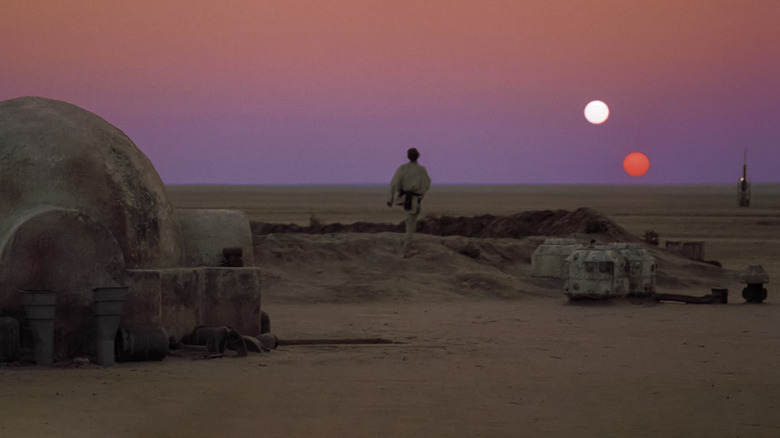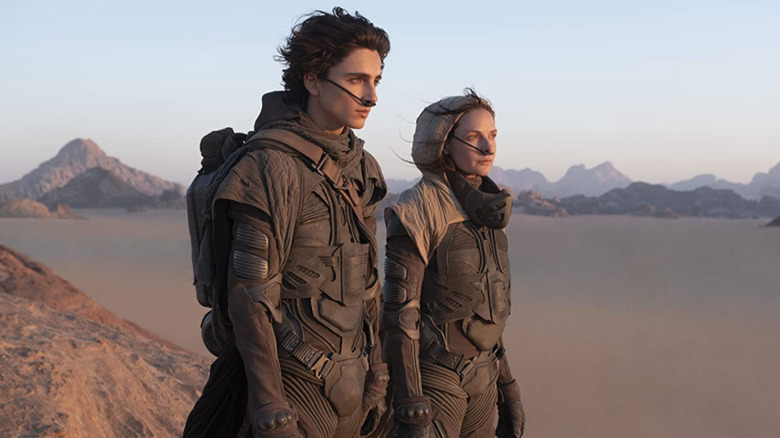Why Sci-Fi Planets Like Arrakis Or Tatooine Aren't Accurate, According To NASA
Why do so many of us have a fascination with dry, desert planets? When Cooper is clobbered by a wall of water on a strange planet in the emotional masterpiece that is "Interstellar," it's exciting. But the focus isn't on the inhospitable planet itself, and the aqueous landmass is quickly left behind. Any time Picard, Kirk, or any other group from Starfleet lands on yet another Garden of Eden-esque oasis on a planet far, far away, the Earth-like setting doesn't do much for most viewers.
But cover a set in sand or take cameras out to the Jordanian desert and create a show based on a planet with a dry-as-a-bone atmosphere, and we're all glued to the screen. Despite having Republics and Empires to explore, "Star Wars" returns time and again to the lawless Outer Rim deserts of Tatooine, and fans follow without complaint. The "Dune" universe is built specifically on the mesmerizing antics of creatures and commodities found in the deserts of Arrakis. While these arid regions seem more believable as livable planets than mountain-high walls of water, are they actually realistic? Is it possible for sci-fi planets like Tatooine to bear native life, like womp rats and sarlaccs? Can a planet like Arrakis host an invasive species like the sandworms for the long term?
NASA has weighed in on the question, and its best minds say no. (Sorry, guys.)
Less water equals no life
Everyone knows that you need water to live. However, NASA scientists have found some new reasons water is required for life — not just individually but on a planetary scale. New data from NASA's Habitable Worlds Observatory project highlights that water is essential to the stability of entire ecosystems.
Water maintains key factors, like temperature fluctuations, and without it you don't get livable settings like Dune or Tatooine. Instead, you get violent swings in temperature. This means you're more likely to get a "3 Body Problem" effect where a planet goes through stable and unstable periods marked by constant and violently changing environmental conditions, respectively. (Although Netflix's show has some sciencey challenges of its own, too.)
Haskelle Trigue White-Gianells, a Washington University Ph.D. student, shared some interesting further insights into the findings via Space.com, saying,
"These arid, dry planets, with significantly less than one Earth's ocean of water may be common throughout the universe. We found that there is a threshold of water needed to maintain a stable climate."
She added that even if a planet is technically in a "habitable zone," it would still require enough water to maintain a stable atmosphere for life. White-Gianells would know more than most, as she has helped run computer simulations designed to track the evolution of desert planets. The result of these experiments revealed that it is highly unlikely life could survive the hostile temperature fluctuations that occur when planetary water falls below a certain quantity.
Keeping water around
The other issue with the habitable desert planet concept is that what little water there is doesn't even appear to stick around if there isn't enough of it. Researchers estimated that a planet like Earth could maintain a stable climate for billions of years. In contrast, if there is less water to work with, a planet will eventually lose what little water it had in the first place. This would make basic things like regulating carbon dioxide levels impossible, and the resulting desertification process would wipe out any native life as the planet developed wild temperatures and dried out, turning it into little more than a barren rock.
While this makes the native species of Tatooine a non-starter, it doesn't mean a sci-fi planet couldn't be populated after the fact. There are plenty of groups, including the sandworms and Fremen of Arrakis and the countless riff-raff of Tatooine, who could theoretically colonize an area after a planet's violent erasure of water. However, any hint at planets easily bearing life or even making life relatively easy once they're in a desert state is simply not in the cards, and significant temperature swings would remain a threat on a daily basis (or whatever a "day" might be in each planet's case).
White-Gianella's final words are cold comfort to sci-fi fans everywhere. "Sci-fi fiction worlds are probably not real," she said. "So I'm sorry to those fans." We are too, Gianella. We are too.


